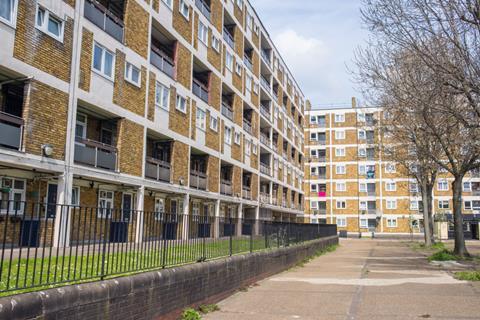
Liz Peace, former chief executive of the British Property Federation and now senior independent governor at the RICS, is this weekâs guest on the Home Truths podcast.
Having focused on commercial property during her 13 years at the BPF until 2014, she has since taken up a series of high-profile roles including becoming the chair of the Old Oak and Park Royal Development Corporation, overseeing the delivery of thousands of homes in west London.
She was also picked to chair the sponsor body overseeing the Palace of Westminsterâs refurbishment in 2018. MPs later decided to disband the board â or, as Peace says in the interview, âSir Lindsay Hoyle and Jacob Rees-Mogg said they wanted to take back control and do it themselves.â
In todayâs podcast she talks about the many housing and planning reviews she has witnessed during her time in the property industry, and how successive governments have failed to tackle the fundamental problems in the housing market.
Also listen to:
>> Episode 1: In conversation with Peter Freeman at Homes England
>> Episode 2: In conversation with Jennie Daly at Taylor Wimpey
>> Episode 3: In conversation with Toby Lloyd, former No 10 adviser
Jackie Sadek and Peter Bill, the podcastsâ co-hosts, ask Peace to explain her proposed financial model that could combine a government kick-start fund with private finance to build homes that would be genuinely affordable.
Here are some extracts from the interview, which is available to listen to via the player above or wherever you get your podcasts.
Q: Tell us about some of the non-executive roles had ever since youâve left the British Property Federation and how they altered your experiences
A: Well, my husband reckons Iâve been training for a non-exec role all my life [where you] parachute in, give people the benefit of your opinion, and then bugger off. But actually, itâs not quite as straightforward as that. With being a non-exec come substantial responsibilities.
All of the roles Iâve done have had something to do with the built environment, and quite a lot with a strong public sector basis to them. I chaired the Government Property Agency and helped set it up and got it running for a year or so before I before I stood down.
Sometimes in a non-executive role, you do not succeed. The Palace of Westminster [for example], Iâm afraid the board that I chaired, we were sacked, because we came up with the wrong answer. So we were sacked. And Sir Lindsay Hoyle and Jacob Rees-Mogg said they wanted to take back control and do it themselves.
Iâve chaired Old Oak and Park Royal Development Corporation since 2017. Thatâs been a sort of labour of love and faith and [a case of] hanging on in there while we found a good solution. Iâm delighted to say I think we have got a very deliverable solution now, but itâs taken a fair bit of failure on the way â and now weâve really got there.
I think one of the points we had to keep explaining to the London Assembly is that regeneration doesnât happen quickly or easily. Look at any major regeneration project, and how long has it taken? How long has it taken to get Barking Riverside going? How long did it take ultimately, to deliver to deliver Kingâs Cross? How long is it taking Earlâs Court? You know, so regeneration projects are never are never straightforward.

I had stint at Redrow Homes and spent seven years on the board of Peabody, the housing association, where I learnt a huge amount about social housing and how housing development could support social housing. Iâm now sitting on the University of Cambridge property board â they have quite a long time horizon, having been around for 700 years.
Most recently Iâve taken up with a company called Greencore homes, run by Jon Di-Stefano, which has got a potentially disruptive model for building genuinely sustainable homes â not just net zero carbon, but negative net zero carbon.
Q: And whatâs your role at the RICS now?
A: Following the difficulties they had two years ago, they appointed somebody called Michael Bichard to do a broad review of how to improve the way they manage their governance. One of his recommendations was that the governing council and the board should have a senior independent governor. I felt I knew the RICS pretty well from a public policy perspective; I knew far less about things like its standard setting and regulation, which Iâm finding very interesting. But yes, there are some interesting challenges.
Q: Letâs start by talking about Kate Barker, her original review into housing in 2004 and the latest review she is working on.
A: Barker did two reviews, of course; she did one into housing, and then she did one into planning. And I think the second came about because, once the government received her findings on the first, they came to the conclusion that the answer to the housing problem was planning. So she was invited to do a second, I think itâs fair to say I remain slightly skeptical as to just how much difference her findings actually made.
I havenât actually revisited them recently, but I donât recall them moving the dial in any way. I find it intriguing that weâve gone full circle. And sheâs coming back in to lead another housing review.
The interesting question to ask is whatâs changed in in that intervening period? And it sort of feels like not a lot, and that weâve actually gone backwards. If you look at the housing numbers now, nobodyâs meeting the targets that have been set.
There are two things that are wrong with the current governmentâs â and potentially future governmentâs â perceptions of the housing industry. So letâs deal with this on housebuilders first. There are a relatively small number of major housebuilders. A commercial housebuilder builds what he can sell at the price that gives him a respectable profit. And if at any point heâs not doing that, he slows down in his building.
Weâve actually seen over the last year or so a number of sites where the building has actually slowed down completely, because suddenly the housebuilders arenât selling at the rates that they need to sell at to make that profit. Why should they build a whole load more houses [when] theyâd have to reduce the price in order to get rid of them? Thatâs not in their interest. It is also an industry because of the way itâs constructed, where you just lay off pools of brickies, you lay off your carpenters, you donât have to have directly employed labor force. So you just donât hire them for that period.
So housebuilders will build what they can sell. Our potential new government is saying, âWeâve got to get the builders building again,â but you wonât get the builders building again if there isnât the customer base out there. And, of course, the customer base wonât actually solve the housing problem because a whole load of the people who need homes couldnât afford to buy from a commercial housebuilder anyway. Thatâs [where we need more] social housing, the old council housing.
The second thing is the planning system: [governments say] âletâs sort out the planning systemâ. Well, I remember when I joined the BPF back in 2002, my predecessor said, âWhat youâll find is about every four or five years somebody in the government will have to have a major review of housebuilding. Everybody will run around in circles and think theyâve come up with lots of brilliant ideas, and nothing will happen. And itâll all go quiet. And then five to 10 years later, the whole thing will start all over again.â Point proven, I think.

Q: Except it feels more frequent than every five to 10 years, surely?
A: Youâre right. But the problem [is] there is actually nothing wrong with the planning system as constructed. Itâs how itâs actually used and implemented. Itâs massively under-resourced, itâs been made massively overcomplicated, for lots of reasons. Itâs become sort of stuck.
The only way you could fundamentally change the planning system, I believe, is by taking the democratic element out of the decision-taking. You put the democratic element in at the plan-making stage. You fix your plan. You have perhaps a system of zoning, design codes. So the point at which the planning application goes in, it becomes a technical matter: does it fit all these different criteria?
I donât believe any government would ever make that reform, because I think it would be just too controversial. And if youâre not prepared to make that reform, stop faffing around with the system and look at how you can actually resource properly.
Q: There are 6.2 million households that cannot afford more than ÂŁ100 a week in rent. Is the only rational answer to build a lot of houses where the building costs and the land are paid for by the state?
A: Part paid for, perhaps. If youâve got people living in homes, paying rent, you do at least have some element of income, which is not unattractive for people out in the investment world. Itâs an incredibly steady income because you never get any voids. If youâre in private sector, you have the possibility of voids.
So I donât see why with an element of subsidy, but not subsidy for the full cost, you couldnât construct a model with some central government investment, which creates some sort of evergreen fund because you have income from all these different types of housing tenure, and you would be able to eventually repay the debt and and start all over again. Itâs not perfect, and I donât know exactly how it works. And Iâm pretty sure you would still need something to kick-start it in terms of a substantial pot of government money.
Q: So you feel a revolving fund solution is there, with a bit of kick-starting from government?
A: Yes, probably quite a big kick-start. But then what are we spending on housing benefits? Let alone all the health outcomes from being inadequately housed? Kids growing up in hotel rooms where they donât have a proper family life and all the other problems?
Q: Okay, if we put you in charge as âgoddess of housingâ, how would you make your plan work?
A: So, youâve got to have a government that actually understands the problem. And this is where I really, really hope our new prime minister, whoever that is, brings in the right people who can talk to him about this. And it isnât just the volume housebuilders. I think over the past decade or so thereâs been a tendency to rely on one or two key private sector housebuilders who think it is all about planning. Iâve already debunked that one.
Q: So if say Matthew Pennycook [shadow housing minister] became the next housing minister and wanted to bring this funding solution to life, what would you say to him?
A: Iâd bring together a very small task force, not too many people â because there would be an awful lot of people angling to get in on this. So four or five key people from investment institutions, banks, and financial folk as well as Treasury. And you effectively lock them in a room until they come up with a scheme and how it would work: What would we expect from the from the private sector? What would we expect from the ongoing investment vehicle?
You would need to see what the bill was going to be up front. And then Iâd asked the Treasury folk to do some sensible costing around what potentially that might save in overall public expenditure over the next 10 years, because that would be part of your justification for allocating funds.

Q: And the scope of it would be building houses that people can afford at council house rents?
A: Itâs a council housebuilding programme. I donât quite see why we have such an aversion to the concept of council houses. My granny lived in a council house. In fact, I lived in one for about the first year of my life, apparently.
Q: Would you have a target? Would you avoid a target? Or would you demand a target?
A: I would look at it from the perspective of the financial model initially, and ask how many could I actually achieve. Letâs prove the concept rather than setting a daft number that nobody can conceivably achieve. Letâs look at the art of the possible. If we managed to do 50,000 with this over a three-year period, then letâs see how we can roll that out and extend it.
Q: I think your financial modelling group would have to include land as well as money in their calculation. So in other words, youâd be giving the land to the fund, otherwise it doesnât work. And then you get an argument about: whatâs the land value to the current owner?
A: I agree. When I first joined the British Property Federation, this was when Lord Faulkner had come up with this idea of a tariff. So it was all going to be a tariff-based system and when you built a house you paid with the roof tariff.
But the Treasury pointed out this would effectively become a tax and therefore all revenue will go to the Treasury. So that all went for a ball of chalk. And if I recall, there were quite a few people in the property industry who thought it was quite a good idea, and would have been quite interested in that. Then, of course, from Kate Barker we got the idea of a planning gain supplement, PGS.
Now, Kate always said that she had only intended this ever to apply to homes, residential development. The government decided to move it forward based on all development, including commercial, and I can remember having a discussion about how totally impossible this was because you couldnât determine the value of the building unless you had a transaction. And therefore how on earth did you determine the value of your planning gain supplement? If youâve got a house, itâs a lot easier, you build it, you sell it, thereâs a number there that you can tax. So the BPF at the time fought strenuously against PGS.
And then finally, ministers and their civil servants came up with the idea of a community infrastructure levy [CIL], which was proposed by Labour. Then with the change to the coalition in 2010, the new government decided to keep it going.
I was subsequently invited by the government to do a review of it. The idea of CIL was actually quite good. It was going to be a relatively low level levy. So enough to actually yield something meaningful, but not enough for them to go into overdrive in terms of opposing it. And therefore, it was going to be very simple.

Q: But just to be clear, was that as well as section 106?
A: Section 106 was still necessary for the planning improvements without which a site would [not] be able to [be] grant[ed] planning permission. So if youâre building something, and itâs essential that to have a new access road, that would be a section 106 related to that site. The community infrastructure levy was about the much broader requirement for infrastructure across a wider area. So the fact that youâre going to be developing 5,000 homes in this area might actually need mean that the city or town needs to build a new doctorâs surgery or something, that would be funded by CIL.
Now, for reasons which I never understood, affordable housing was left in the section 106 bid for negotiation. Whereas I actually thought affordable housing ought to be part of the essential infrastructure. So the problem is that if you make your CIL too big, youâre putting pressure on your section 106. And therefore the affordable housing, because thatâs the bit of the section 106 you can flex â because you canât flex the absolutely essential road [that is needed for] planning purposes â so the section 106 housing bit gets squeezed out.
Q: Your review â what was your review about?
A: It was looking at how effective CIL was and what we could we do to improve it. And I must admit, I think that was possibly intellectually the most awful 12 months Iâd ever spent because it was just so incredibly difficult.
We sat around agonising, and it was right back to the first principles: How do you manage to extract an element of the value in a way that is fair to both the landowner or the building owner, but also allows the state to benefit from the uplift in value for which an awful lot of people have done precious little, particularly a long-term landowner? We never came to a really good solution. We came up with an alternative. We looked at how to take out some of what by then had become a real industry around CIL. I used to say [to the lawyers]: âIâm trying to put you out of business here [because] what we want stop CIL being in the industry it has become, get it back to something very, very simple.â We did come up with a series of recommendations, which of course were all totally ignored.
Q: One of the things weâre learning about 106 is itâs a very opaque process. The general public donât know what benefits theyâre getting out of this, out of 106 agreements with big developers. Is that something that resonates with you?
A: Yes, that, of course, was what the community infrastructure levy was designed to solve. The local authority in setting its levy was supposed to start off by looking at what additional infrastructure that development would give rise to. It wouldnât be able to fund it all from CIL, so there would still have to be other mechanisms, but agreeing what proportion of vital infrastructure CIL would deliver was all supposed to be a totally transparent process.
If you made sure that all that infrastructure did come along with a housing development, then you would give the objectors less grounds to complain. And itâs not all to be planned and provided for by the developers; youâve got to have a local authority thatâs robust enough to have planned it properly. But whatâs the percentage of local authorities that havenât even got an up-to-date local plan? I wonder what commercial business would get away with not having a strategic plan to present to its investors?
Q: Our final question â if you had a magic wand, what is the one thing that you would do to solve the problems in the housing sector?
Iâve talked a lot about the financials, but I think part of that is getting the right settlement on land value. If I was being really wicked, Iâd say in some ways youâve just got to nationalise the land supply, havenât you? And pay back to the landowners a due proportion, but not all.

>> Click on the player at the top of this story to hear todayâs episode


































No comments yet